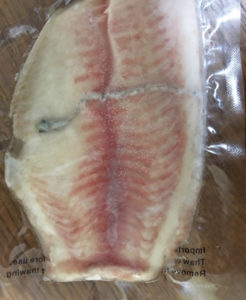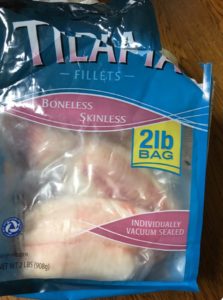Column: Incomplete South Carolina news piece leaves retailer, importers picking up the pieces

Numerous “articles” questioning the safety or healthfulness of farmed tilapia continue to swirl about the Internet, making life difficult for an already embattled sector of the aquaculture industry. As one of our contributing writers reported last year in What will it take to make tilapia great again? click-bait headlines with a loose grip on facts can do tremendous damage in this short-attention-span-theater we all live in 24 hours a day.
Consumers’ waning trust in tilapia, spawned mainly from posts on major social media platforms instead of reputable news sources, was becoming “frustrating” to a prominent U.S. importer we talked to. The National Fisheries Institute, the leading U.S. seafood industry business association, said it “fought the misinformation hard.” It’s difficult for anyone, however, to quantify the financial impact of what amounts to – and it pains me to write these words – fake news.
A Fox Carolina TV news report, aired on the afternoon of Aug. 4, depicted a consumer claiming to have made a “shocking discovery” in a bag of frozen tilapia she purchased at a Walmart store in Powdersville, S.C. On the surface of the frozen, skinless and boneless fillet was what appeared to her to be a “snake.”
The “concerned” woman, whose face was not shown on camera, as if she were in the witness protection program, called for the retailer to pull the product from its shelves, saying it would be the right thing to do. The product in question also sported a Best Aquaculture Practices certification logo, which was mentioned prominently in the story.
The reporter, possibly sensing an opportunity to become the next Jeff Rossen, sent cell phone images of the fish fillet to someone she identified as a professor of aquaponics at Clemson University, one of the state’s leading academic institutions. Without identifying anyone at the school by name, the source was reported to have identified something that appeared “similar to a nematode or a tapeworm.”
Seafood processing workers and weekend anglers would certainly not be surprised by the presence of a worm in a fish fillet. As a native Mainer, I’m familiar with a process known as candling, in which cod or haddock fillets, for example, are placed atop lighted tables to quickly find little inch-long, naturally occurring marine worms called nematodes. Their presence is not uncommon. They are harmless but are rather easily removed.
Walmart issued the following response to the news outlet: “We are committed to providing our customers with safe, quality foods. We encourage customers with questions about our products to return to the store and speak with a member of management.” Apparently a full refund wasn’t enough.
Well, it turns out that what was on that tilapia fillet was almost certainly not a worm. I made one phone call to Clemson University and was quickly connected to the man who was asked to analyze the fish fillet in question. Lance Beecher, an extension specialist (not an aquaponics professor) at the school, has been studying and practicing aquaculture for 25 years and is familiar with the farming of catfish, tilapia, cobia, bass and numerous other finfish species. He has a Ph.D. He’s also a passionate fisherman who’s encountered a worm or two.

Beecher told me that he was never sent any samples, only images via email that the reporter asked him to review. On his cell phone. While he was driving.
“She called me at 1 [p.m.], while I’m in the field working on a project,” Beecher told me last week. “She said, ‘I need you to look at it right now. I need something, I want to run with the story at four.’ Which was surprising, I figured that’s probably not the best way to do things. I told her that.”
Then what was it, if it wasn’t a worm? “After looking at it closely,” said Beecher, who examined the images on a larger computer screen later that day, “that’s definitely a piece of skin that was not cut off properly. To me it was poor quality control, if anything.”
I asked Beecher if he was certain. “I’ve filleted many a fish,” he said. “After I looked at it really close-up, I had no doubt.”
It’s painfully difficult for me to criticize a peer for doing a sloppy job of reporting. I know all about deadline pressures and the never-ending quest for clicks and how those demands can impair one’s typically sound judgement. I know, firsthand, the risks of going to press too soon, for I once published an article before getting official confirmation of facts, and paid a heavy price for the error. The erroneous report was removed that day, but the incident remains with me.
This Fox video clip remains online, several weeks later, doing continued damage to an industry that frankly doesn’t need it. Making matters worse, it’s also been reposted on other sites, and shared thousands of times through social media, with who knows what kind of negative message attached to it. Unfortunately, as Beecher noted, this is one of many similar instances that’s dogged farmed fish for decades.
“I’ve seen all these claims that tilapia is horrible, and try to defend that as much as possible. I’m tired of hearing that stuff,” he said. “I told [the reporter], why don’t you come and do a story on aquaponics and aquaculture instead of slamming it.”
I contacted the reporter as well, but as of press time she had not returned my call.
In the end, the 3-minute seafood-scandal segment she probably hoped would go viral actually did. But it was really just another fish tale that hardly anyone will hear the truth of. Meanwhile a major retailer – one that has made unprecedented commitments to sustainability, social responsibility and food safety – a leading university, a respected certification scheme and an international industry are left to shovel the mess left behind.
No candling is needed to see where this mistake was made.
Author
-

James Wright
Editorial Manager
Global Aquaculture Alliance
Portsmouth, NH, USA
Tagged With
Related Posts

Intelligence
Telling aquaculture’s story, with every sale
In his latest piece for the Advocate, industry veteran Phil Walsh, VP of Growth for Alfa Gamma Seafood Group in Miami, says aquaculture stakeholders should seize every opportunity to promote their products’ positive attributes in the face of stiff opposition.

Intelligence
The one that got away from the New York Times
Seafood industry veteran Phil Walsh takes a satirical look at how mainstream media filter news reports about wild and farmed fish. But the marketplace influence of unnamed “insiders” is no joke.

Innovation & Investment
Aquaculture Exchange: Barry Costa-Pierce, UNE
University of New England Professor Barry Costa-Pierce says aquaculture is often neglected in studies examining ocean health and ecosystem and resource management. The “Ocean Prosperity Roadmap” released this summer, he said, was more of the same.

Intelligence
Boston brainstorm: Getting consumers to embrace aquaculture
In a discussion format somewhat unique to the bustling halls of Seafood Expo North America, aquaculture backers lamented the lackluster U.S. consumer acceptance for farmed fish.

